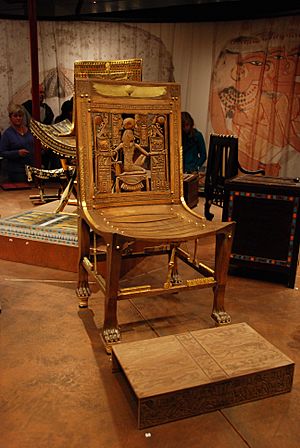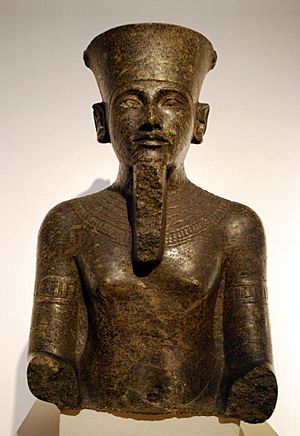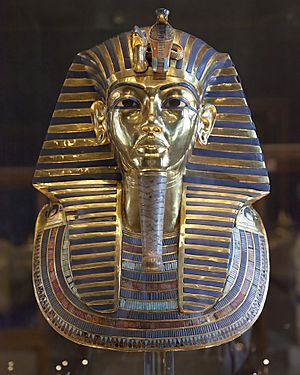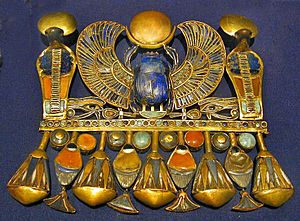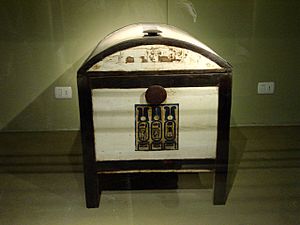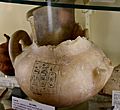Tutankhamun facts for kids
Quick facts for kids Tutankhamun |
|
|---|---|
| Tutankhamen, Tutankhaten, Tutankhamon, possibly Nibhurrereya (as referenced in the Amarna letters) | |
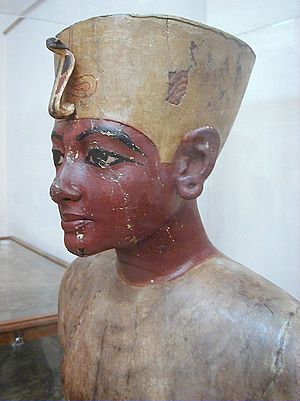
Wooden bust of the boy king, found in his tomb
|
|
| Pharaoh | |
| Reign | c. 1332–1323 BC, New Kingdom (18th Dynasty) |
| Predecessor | Neferneferuaten |
| Successor | Ay (granduncle/grandfather-in-law) |
| Consort | Ankhesenamun (half-sister and cousin) |
| Children | Two stillborn daughters |
| Father | Akhenaten |
| Mother | "The Younger Lady" |
| Born | c. 1341 BC |
| Died | c. 1323 BC (aged c. 18 or 19) |
| Burial | KV62 |
Tutankhamun (sometimes called King Tut) was a Pharaoh of Ancient Egypt from about 1334 BC to 1323 BC. He became Pharaoh of the 18th dynasty (royal family) during the New Kingdom at the age of 9.
Tutankhamun is one of the most well-known ancient Egyptian kings in modern times. Interestingly, he was not considered to be very important in ancient times and was not recorded on most ancient king lists. However, the discovery of his tomb in 1922 made him a celebrity. King Tut's tomb was one of the few that had not been robbed. The well-preserved items in it gave archaeologists an idea of what may have been in other kings' tombs.
Contents
Reign
Tutankhamun was the son of Akhenaten. Tutankhamun ruled for 9 years and died very young, at 18, so he is known as "The Boy King."
He was married to Ankhesenamun, daughter of Queen Nefertiti, who was his step mother.
Given his age, the king probably had very powerful advisors.
In his third regal year, Tutankhamun reversed several changes that his father had made. He ended the worship of the god Aten and restored the god Amun to supremacy. He moved the capital back to Thebes. This is when he changed his name to Tutankhamun, "Living image of Amun," reinforcing the restoration of Amun.
As part of his restoration, King Tut started building projects. He built the Karnak in Thebes, monuments, and images of the gods. He restarted the traditional festivals related to the Apis Bull, Horemakhet, and Opet.
King Tut's father, Akhenaten, had left the country economically weak. Diplomatic (friendly) relations with other kingdoms had been ignored, and Tutankhamun tried to restore them. He was successful with the Mitanni but unsuccessful with the Nubians and Asiatics, whom he battled.
Health and appearance
Tutankhamun was thinly built, and roughly 5ft 11in (180 cm) tall. Research has shown that Tutankhamun had many health problems:
- "a slightly cleft palate"
- possibly a mild case of scoliosis, a medical condition in which the spine turns to the side from the normal position
- Klippel–Feil syndrome: all seven vertebrae of his neck were fused, so he was unable to move his head
- deformations in his left foot, caused by necrosis (poor blood supply) of bone tissue
- DNA from the mosquito-borne parasites that cause malaria
- a fractured left thighbone (broken leg)
Illness and death
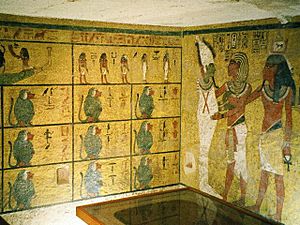
Recent studies of his body using CT scans and DNA tests show that he was a very frail person who probably needed a walking stick. Scientists now believe he died from a broken leg, made more complicated by bone disease and malaria. Before this discovery, there were many theories about his early death, including murder. It is quite certain that he was infected by several strains of malaria and very likely that he had some genetic defects.
Discovery of Tutankhamun's tomb

Tutankhamun was buried in a tomb that smaller than other kings' tombs. Archaeologists guess that he may have died unexpectedly before his tomb was ready, and his mummy had to be buried in a tomb intended for someone else. It has been suggested that his tomb was never opened by either grave robbers or priests because both he and it had been forgotten.
The Egyptologist Howard Carter (employed by Lord Carnarvon) discovered Tutankhamun's tomb on November 4, 1922, near the entrance to the tomb of Ramses VI. This brought attention and interest in Egyptian things to the modern world. A few weeks later, on November 26, both men became the first to enter Tutankhamun's tomb in over 3000 years. After many weeks of careful excavation, on February 16, 1923, Carter opened the burial chamber and first saw the sarcophagus (coffin) of Tutankhamun.
5,398 items were found in the tomb, including a solid gold coffin, face mask, thrones, archery bows, a dagger that may have had a blade made from a meteorite, trumpets, a lotus chalice, food, wine, sandals, and fresh linen underwear.
Tutankhamun's mummy still rests in his tomb in the Valley of the Kings. On November 4, 2007, 85 years to the day after Carter's discovery, the 19-year-old pharaoh went on display in his underground tomb at Luxor. In January 2019, it was announced that the tomb would re-open to visitors after nine years of restoration.
Significance
Tutankhamun was nine years old when he became Pharaoh, and he reigned for about ten years. Tutankhamun is historically significant because his reign was near the rise of Egypt as a world power and because he rejected the radical religious ideas introduced by his father, Akhenaten. Secondly, his tomb in the Valley of the Kings was discovered by Carter almost completely intact—the most complete ancient Egyptian royal tomb found.
Kings were revered after their deaths through cults and associated temples. Tutankhamun was one of the few kings worshiped in this manner during his lifetime. A monument discovered at Karnak and dedicated to Amun-Ra and Tutankhamun shows that the king could be asked in his deified state for forgiveness and to free the seeker from a disease caused by sin. Temples of his cult were built as far away as in Kawa and Faras in Nubia.
Legacy
Tutankhamun is one of the world's most famous pharaohs because his tomb is among the best preserved and exhibited (shown). Relics from his tomb have been shown in exhibits around the world.
"King Tut" became the name of products and businesses. Even the U.S. President Herbert Hoover named his pet dog "King Tut."
Interesting facts about Tutankhamun
- Tutankhamun changed his name from Tutankhaten. His old name (given to him by his father) meant "living image of Aten" and he wanted his new name to show his allegiance to the god Amun.
- King Tut liked to hunt ostriches. He made a fan with their feathers.
- He had a club foot and owned over 100 walking sticks.
- No one knows exactly why he died so young.
- He has the smallest royal tomb in the Valley of the Kings. It is likely because he died unexpectedly and his tomb was not ready.
- He was laid in three nested golden coffins (like a set of Russian dolls).
- King Tutankhamun's tomb is one of the smallest found in the Valley of the Kings, consisting of only four chambers and an entrance staircase and corridor.
- The tomb of Tutankhamun is in higher demand from tourists than any other in the Valley of the Kings, and up to 1,000 people pass through it on its busiest days.
Images for kids
See also
 In Spanish: Tutankamón para niños
In Spanish: Tutankamón para niños


